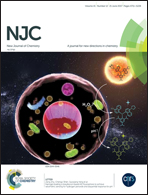Four Salamo-type 3d–4f hetero-bimetallic [ZnIILnIII] complexes: syntheses, crystal structures, and luminescent and magnetic properties†
Abstract
Four hetero-bimetallic [ZnIILnIII] complexes with the general formula [Zn(L)(OAc)Ln(NO3)2] (Ln = Sm, Eu, Tb and Dy) were synthesized by the Salamo-type ligand H2L (6,6′-diethoxy-2,2′-[1,2-ethylenedioxybis(nitrilomethylidyne)]diphenol) with Zn(OAc)2·2H2O and Ln(NO3)3·6H2O (Ln = Sm, Eu, Tb and Dy), respectively. X-ray crystal diffraction analyses revealed that all the Zn(II) atoms were penta-coordinated, adopting distorted square pyramidal geometries, and the Ln(III) atoms were nona-coordinated, forming distorted tricapped trigonal prism geometries. In addition, three-dimensional supramolecular structures were assembled through intermolecular hydrogen-bond interactions. In the [ZnIILnIII] complexes, only [Zn(L)(OAc)Sm(NO3)2] showed obvious orange-red light emission under UV light due to the characteristic f–f transitions of Sm3+ ions, which meant that the ligand H2L could transfer energy from its excited state to the lowest excited state of the Sm3+ ion effectively. A decrease in the χMT value illustrated weak antiferromagnetic interaction exciting in the [Zn(L)(OAc)Tb(NO3)2] and [Zn(L)(OAc)Dy(NO3)2] complexes.
![Graphical abstract: Four Salamo-type 3d–4f hetero-bimetallic [ZnIILnIII] complexes: syntheses, crystal structures, and luminescent and magnetic properties](/en/Image/Get?imageInfo.ImageType=GA&imageInfo.ImageIdentifier.ManuscriptID=C6NJ04090J&imageInfo.ImageIdentifier.Year=2017)


 Please wait while we load your content...
Please wait while we load your content...